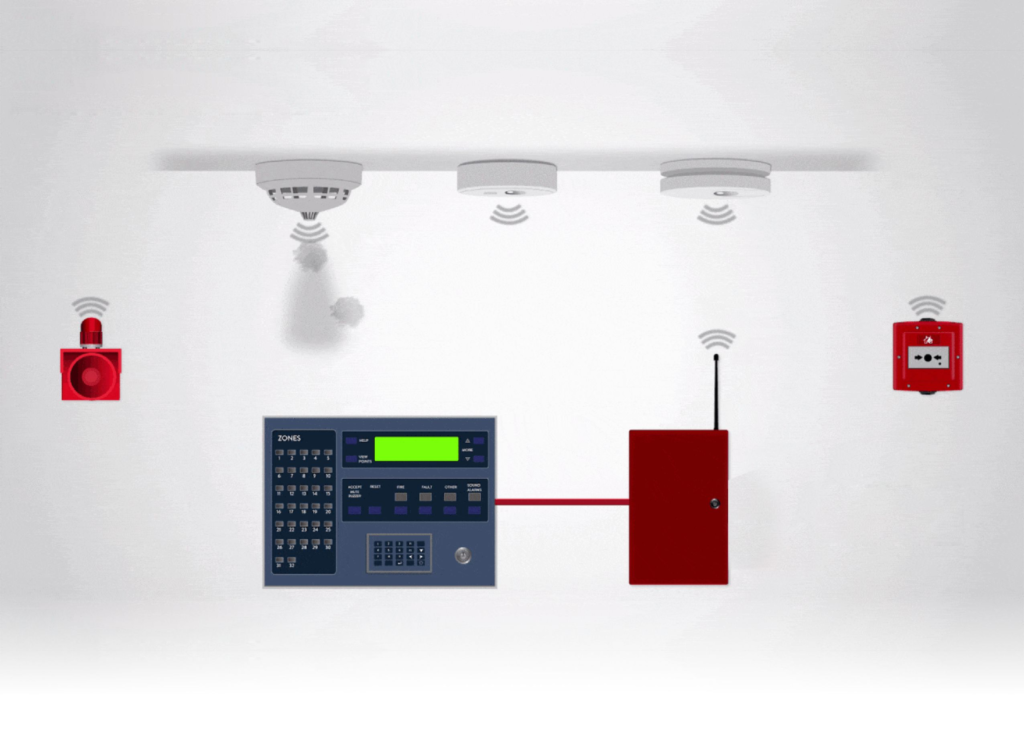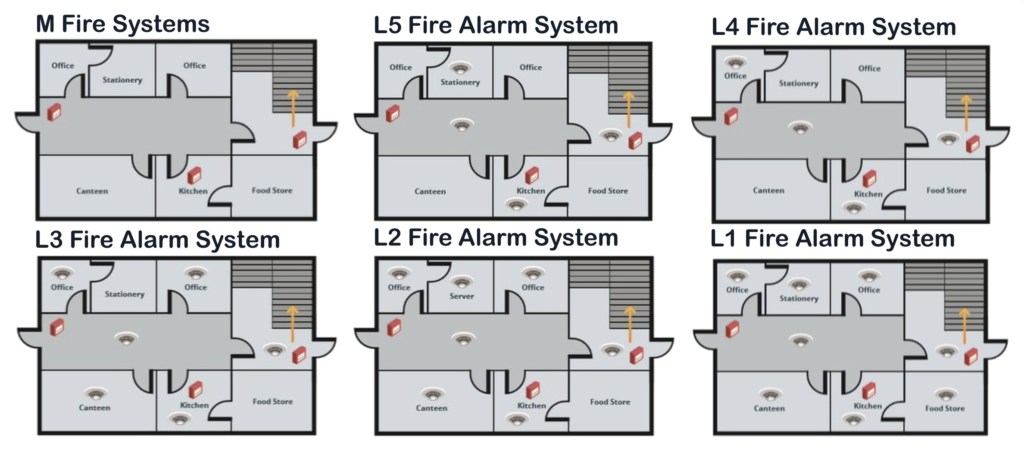Table of Contents
ToggleA Guide to Commercial Grade A Fire Alarm Systems

Introduction
A commercial fire alarm system is a critical safety feature for businesses. It ensures early detection of fires, allowing occupants to evacuate promptly. In this guide, we’ll cover various aspects of commercial fire alarm systems, emphasizing their importance, types, real-world applications, and compliance with UK standards.
1. The Importance of a Compliant Fire Alarm System
Having a compliant fire alarm system is essential for businesses of all sizes. Let’s revisit why:
Early Detection and Quick Response
- Fire alarm systems excel at early hazard identification.
- Early alerts allow occupants to protect themselves and evacuate safely.
- Monitored fire alarms also alert the fire department for swift containment.
Avoiding Smoke Inhalation
- Smoke inhalation is a leading cause of fire-related deaths.
Over half of fire deaths result from inhaling harmful smoke particles and gases. When you breathe in smoke, it inflames your lungs and airway, leading to oxygen blockage. This can cause acute respiratory distress syndrome and respiratory failure. Immediate medical attention is crucial if you suspect smoke inhalation . 🚒🔥
- A fire alarm system is crucial for timely evacuation, preventing smoke-related fatalities.
Fire alarm systems play a pivotal role in safeguarding lives and property. When a fire erupts, these systems provide early detection, allowing occupants to evacuate promptly and summon emergency services. By minimizing response time, fire alarms help prevent injuries, reduce damage, and enhance overall safety.
Minimizing Costs And Saving Assets
- Effective fire alarm systems save money by minimizing property damage and protecting assets.
Investing in robust fire alarm systems is akin to safeguarding your financial well-being. These systems serve as vigilant sentinels, standing guard against the unpredictable fury of flames. By preventing extensive property damage, they preserve valuable assets and reduce costly repairs. Their proactive approach pays dividends in both safety and savings.
Moreover, consider the ripple effect: A single fire alarm activation can prevent a chain reaction of devastation. It not only shields your physical assets but also safeguards livelihoods, memories, and the very fabric of your environment. Imagine the relief of knowing that your business documents, family heirlooms, and cherished photographs remain unscathed, thanks to a timely alarm.
So, when you hear that reassuring beep or blaring siren, remember that it’s not just a sound—it’s a lifeline. It’s the promise of protection, the shield against catastrophe, and the guardian of your peace of mind.
2. Types of Commercial Fire Alarm Systems
Let’s explore the common types of fire alarm systems suitable for commercial settings:
a. Conventional Fire Alarms

Conventional fire alarm systems are the stalwarts of fire safety. They operate on a straightforward principle: zone-based detection. Here’s how they work:
- Zones: The building is divided into zones, each equipped with smoke detectors or heat sensors. When a sensor detects smoke or heat, it triggers an alarm within its designated zone.
- Alerts: In case of fire, the alarm sounds, alerting occupants to evacuate. However, conventional systems don’t pinpoint the exact location of the fire—only the affected zone.
- Wiring: These systems use simple wiring, connecting all devices in a zone to a central control panel. If a sensor activates, the corresponding zone’s indicator lights up on the panel.
- Limitations: Conventional alarms lack precision. Identifying the specific area of the fire requires manual investigation. Yet, their reliability and cost-effectiveness make them a popular choice for smaller buildings.
Remember, while conventional fire alarms may not be as sophisticated as their addressable counterparts, they play a crucial role in early warning and life safety.
b. Analogue Addressable Fire Alarms

These intelligent sentinels combine the best of both worlds—analogue and digital technology. Whether you call them analogue addressable, digital addressable, or simply addressable, they all share a common purpose: safeguarding lives and property. Here’s how they work:
- Detection Precision: Unlike their conventional counterparts, which provide information about general areas or zones, analogue addressable systems offer specific details on individual fire detector locations. Each detector possesses its own unique address, akin to a digital fingerprint. When an alarm triggers, it doesn’t just shout “Fire!”—it whispers the precise location.
- Network Capability: These systems are designed for larger buildings, where expansive spaces demand seamless communication. Picture them as a network of vigilant nodes, exchanging information across corridors, stairwells, and hallways. When one detector senses smoke or heat, it discreetly informs its neighbors, creating a synchronized symphony of safety.
- Wiring Efficiency: Addressable systems are savvy minimalists when it comes to cabling. Devices—whether smoke detectors, heat sensors, or call points—are wired in one or more single loops around the premises. The control panel, the system’s brain, receives real-time updates from each device. Imagine it as a conductor, orchestrating a harmonious response during a fire, fault, smoke, heat, or contamination event.
- Constant Monitoring: The control panel is an insomniac, tirelessly polling each device. It receives status reports: “Healthy,” “Pre-Alarm,” “In Alarm,” or “In Fault.” This vigilance ensures swift action when needed. If a detector feels unwell (say, due to dust accumulation), it politely raises its hand, signaling for attention.
- Smart Sensing: The analogue component adds sophistication. Detectors monitor not only smoke but also contamination levels. Imagine them as discerning sommeliers, distinguishing between fine wine (smoke from a genuine fire) and vinegar (dust or false alarms). This feature is especially valuable in settings like airports and banks, where precision matters.
So, next time you walk past an addressable fire alarm, remember: it’s not just wires and sensors—it’s a silent guardian, whispering safety in a language only firefighters understand.
c. Wireless Fire Alarms

- Quick Installation: Ideal for urgent fire alarms, these systems require no cumbersome cables between the control panel and devices. Installation won’t disrupt your building’s aesthetics or daily operations.
- Battery-Powered Reliability: Even during power outages, wireless alarms keep vigil. No wall outlets needed—just battery resilience. Plus, they’re perfect for temporary setups on construction sites.
- Cost-Effective & Reliable: These systems save money on labor and cable clutter. Tested to British and European standards, they’re as dependable as wired counterparts.
- Precision & Adaptability: Each detector has a unique address, allowing pinpoint location identification. Modify layouts easily as your building evolves.
d. Addressable Wireless Fire Alarms
- Combining the benefits of both analogue addressable and wireless systems.
- Provide detailed information and flexibility without extensive wiring.
3. Real Applications for Commercial Fire Alarm Systems
Let’s explore practical scenarios where commercial fire alarm systems play a crucial role:
a. Office Buildings
- Fire alarms protect office spaces, ensuring employee safety during working hours.
- Early detection prevents extensive damage to office equipment and documents.
b. Retail Stores
- Retail environments benefit from fire alarms to safeguard customers, staff, and merchandise.
- Quick response helps prevent stock losses due to fire damage.
c. Warehouses and Industrial Facilities
- Large spaces like warehouses and factories require robust fire alarm systems.
- Addressable systems pinpoint fire locations, aiding efficient evacuation.
d. Hospitality Industry (Hotels, Restaurants, etc.)
- Fire alarms are vital for guest safety in hotels and restaurants.
- Voice evacuation systems guide guests to safety during emergencies.
4. Compliance with UK Standards
Adhering to UK standards ensures effective fire alarm systems:
a. EN 54
Let’s delve into the world of EN 54, a crucial series of European standards that ensures the effectiveness and reliability of fire detection and fire alarm systems:
- What is EN 54?
- The EN 54 Fire detection and fire alarm systems is a comprehensive set of European standards.
- It covers both product standards (defining characteristics, test methods, and performance criteria) and application guidelines for fire detection, fire alarm systems, and voice alarm systems.
- These standards play a pivotal role in safeguarding lives and property by ensuring the quality and functionality of fire safety equipment.
- Product Standards and Harmonization:
- The product standards within the EN 54 series define the characteristics of various components in fire alarm systems.
- These standards are often harmonized under the Construction Products Regulation (CPR) EU 305/2011.
- Annex ZA specifies which sections of the standard apply for CPR purposes.
- The two-stage certification process includes product certification and conformity of factory production control (FPC certification).
- Global Impact:
- While primarily European, the EN 54 series is also used worldwide.
- Beyond the EU, it’s adopted in Latin American countries, Brazil, African and Asian nations, and even Pacific islands.
b. The importance of BS 5839-1
BS 5839-1, which is a British Standard providing guidelines for designing, installing, commissioning, and maintaining fire detection and alarm systems in non-domestic buildings. This standard plays a crucial role in safeguarding lives and property. Here’s a breakdown of the key components:
- Fire Detection and Fire Alarm Systems:
- Objective: To detect fires promptly and alert occupants or emergency services.
- Categories: BS 5839-1 classifies fire alarm systems into three main categories: L, M, and P.

- Category L (Life Protection):
- Purpose: Primarily focuses on protecting lives.
- Subcategories:
- L1: Provides the most comprehensive coverage. Detectors are installed in all areas, including bedrooms, corridors, and escape routes.
- L2: Covers escape routes, circulation areas, and high-risk areas (e.g., kitchens).
- L3: Limited coverage, typically in escape routes and circulation areas.
- L4: Basic coverage, mainly in escape routes.
- L5: Specific protection for high-risk areas (e.g., plant rooms).
- Note: L1 offers the highest level of protection, while L5 provides minimal coverage.
- Category M (Manual):
- Objective: To manually raise the alarm.
- Subcategories:
- M1: Manual call points at all exits, stairwells, and corridors (where occupants walk less than 45 meters to reach a call point).
- M2: Manual call points in specific areas.
- Note: M1 ensures early detection by allowing occupants to initiate alarms promptly.
- Category P (Property Protection):
- Purpose: Primarily focuses on safeguarding property.
- Subcategories:
- P1: Comprehensive coverage throughout the building. Detects fires early to minimize damage.
- P2: Installed in specific high-risk areas only.
- Difference: P1 protects the entire building, while P2 targets specific zones.
- Design Considerations:
- System Type: Choose between conventional, addressable, or wireless systems.
- Components: Select appropriate detectors (smoke, heat, or multi-sensor), manual call points, and control equipment.
- Detection Zones: Divide the building into zones for efficient monitoring.
- Alarm Zones: Define areas within the building.
- Communication with Fire Services: Ensure effective communication during emergencies.
- Alarm Warnings for Impaired Hearing: Accommodate occupants with hearing impairments.
- Installation and Compliance:
- Limiting False Alarms: Implement measures to reduce false alarms.
- Responsibility: Compliance rests with building owners and managers.
- Commissioning: Verify system functionality.
- Documentation and Certification: Maintain records.
5. Manufacturers and Fireproof Cables
a. Renowned Manufacturers
C-TEC, Notifier, Apollo, Kentec, Hochiki, and Gent are reputable manufacturers.
Let’s explore each of these reputable manufacturers and highlight their key contributions to the fire safety industry:

- About: C-TEC is a leading UK independent manufacturer of quality life safety electronic equipment.
- Product Portfolio:
- Conventional and addressable fire alarm systems.
- Power supplies.
- Automatic extinguisher systems.
- Disabled refuge systems.
- Call systems.
- Hearing loop systems.
- Relevance: C-TEC’s commitment to safety and innovation makes it a trusted choice for fire detection and communication solutions.

- About: Apollo, with over 100 years of heritage, leads in designing and manufacturing life safety solutions.
- Product Range:
- Compatible with Kentec, Advances and C-Tec Fire panels
- XP95 Addressable Range: Intelligent sensors with advanced features.
- Custom Solutions: Tailored fire safety systems for unique sites.
- Relevance: Apollo’s expertise, quality assurance, and bespoke solutions set the industry benchmark for reliability.

- About: Kentec is the UK’s largest independent fire panel manufacturer.
- Product Offerings:
- Taktis Fire Panel: Flexible migration strategy for seamless transition from Syncro.
- Custom Built Solutions: Tailored fire safety systems for unique sites.
- K-Mesh Wireless Technology: Cutting-edge wireless fire safety.
- Relevance: Kentec’s commitment to quality, expertise, and bespoke solutions ensures maximum effectiveness in fire safety.

- About: Hochiki, with over 100 years of experience, is a global leader in fire protection equipment.
- Product Excellence: Hochiki’s high-integrity, long-term reliability, and global acceptance make it a trusted name in life safety solutions.

- About: Gent, part of the Honeywell group, specializes in fire detection and alarm systems.
- Product Highlights:
- Vigilon: Addressable fire detection system.
- S-Quad Sensors: Advanced multi-sensor technology.
- Custom Solutions: Tailored to specific requirements.
- Relevance: Gent’s commitment to innovation and safety ensures effective fire protection in diverse environments.
- About: Notifier, a Honeywell company, has been a pioneer in fire detection and alarm technology for over 70 years.
- Product Highlights:
- Innovative Solutions: Notifier provides powerful, intuitive solutions for fire safety in facilities of any size.
- Global Acceptance: Their fire detection and emergency lighting products are globally recognized for high-integrity and long-term reliability.
These manufacturers collectively contribute to safer buildings, protecting lives and property worldwide.
b. Fireproof Cables

When it comes to fire alarm installations, selecting the right fireproof cables is crucial. Here are the main types of fire-resistant cables used in fire detection and alarm systems:
- Standard Grade Fire Resistant Cables:
- Purpose: These cables are suitable for normal-risk fire systems.
- Survival Time: Tested to withstand fire for 30 minutes at a temperature of 830°C.
- Application: Used in most fire detection and alarm systems.
- Examples: Prysmian FP200 Gold or Draka Firetuf.
- Enhanced Fire Resistance Cables:
- Purpose: These cables are essential for prolonged fire survival.
- Survival Time: Tested to endure fire for 120 minutes at a temperature of 940°C.
- Usage Scenarios:
- Buildings over 30 meters high.
- Situations with delayed or multiphase alarm operation.
- Examples: Prysmian FP Plus and other soft-skinned cables.
- Mineral Insulated Copper Sheathed (MICS) Cables:
- Description: These cables conform to BS EN 60702-1.
- Application: Used in fire detection and alarm systems.
- Soft-Skinned Cables (BS 7629):
- Suitable for various applications.
- Often used for detection circuits.
- Armoured Fire-Resistant Cables (BS 7846):
- Steel wire armoured (SWA) cables.
- Provide additional protection in demanding environments.
Remember that choosing the right fireproof cable ensures reliable fire safety and early detection.
At Pulsar Vertex, we prioritize safety. Our fire alarm installations utilize fireproof cables, adhering to the highest standards. Remember, fire safety is non-negotiable. Choose quality manufacturers and invest in fireproof cables for peace of mind. If you have any further questions, feel free to reach out! 🔥🚒

